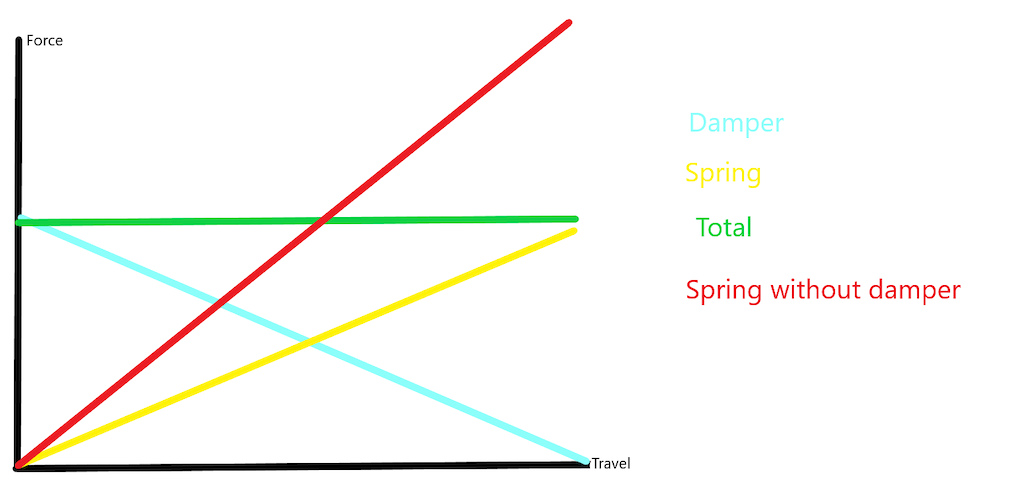
Pushing my MS Paint skills to the limit to show how suspension with compression damping can result in lower peak force than suspension without. It's conceptual, not a precise depiction of an actual event.
Obviously, the damper force can't be maximum at zero travel without infinite acceleration. As I said, it's conceptual. Damper force may peak early in the travel, though.
This chart doesn't address how humans perceive the forces. We're sensitive to the rate at which the force increases, so it may feel unpleasant to have the total force increase quickly, even if it produces a lower maximum force.
4 Comments
- 2 0
Yes, that's correct. Linkage has no way of knowing the speed of the impact. Neither do I, of course, which is why I didn't bother making this diagram super detailed; it's conceptual, not a precise depiction of an actual event. The total force line won't be perfectly flat, no matter how you tune your compression damping, friction is being ignored, etc.
The purpose is just to show why removing too much compression damping may feel "plush", but decreases stability and can increase peak forces, and how the presence of compression damping may be perceived as "harsh", despite - if set up properly - decreasing peak loads.
The purpose is just to show why removing too much compression damping may feel "plush", but decreases stability and can increase peak forces, and how the presence of compression damping may be perceived as "harsh", despite - if set up properly - decreasing peak loads.
- 1 0
Sorry, I'm not all cylinders are fixing this morning and failing to intuit the meaning. Care to hold my hand and walk me through it?
- 1 0
It's an approximation of two ways to set up your shock to provide sufficient support. The area under the curve represents the total impact energy handled by the shock (force × travel). The area is the same for the red line and the green line. Let's look at each:
Red line: All spring, no compression damping. Springs are position-sensitive, so the force starts low and it feels supple. It can't stay soft forever, though, and when the force builds, it really builds. The area is a triangle, which is ½(base)(height). For a given amount of travel (base), the force (height) has to be twice as high as it would be if the force had been constant the whole time.
Green line: Spring with compression damping. The spring force is yellow and the damper force is blue; together, they add up to the green line. Dampers are speed-sensitive. The speed is initially high, then drops to zero when the maximum travel is reached for this impact, so the damping force does likewise. The spring force and compression damper force have inverse behaviours: when one is high, the other is low. When the impact begins, the force is immediately high, which feels abrupt and may be mistaken for "harshness", but you can see the maximum force is half as much as without compression damping (the red line). Same energy (area under the line) as the red line, but half the peak force.
The point is to illustrate a common fallacy. When riders want their suspension to feel "plush", the first thing most people do is reduce the damping. This "eases you into" the impact, which feels soft and "plush", but it ramps up abruptly and eventually transmits more force to the rider. A softer spring with more compression damping makes an impact feel more abrupt, which can be a bit startling and the rapid build-up of force can be mistaken for the feel of a sticky fork, but it actually behaves very differently than a sticky fork and can be a way to improve chassis pitch stability while reducing peak loads.
Let me know if you have more questions.
Red line: All spring, no compression damping. Springs are position-sensitive, so the force starts low and it feels supple. It can't stay soft forever, though, and when the force builds, it really builds. The area is a triangle, which is ½(base)(height). For a given amount of travel (base), the force (height) has to be twice as high as it would be if the force had been constant the whole time.
Green line: Spring with compression damping. The spring force is yellow and the damper force is blue; together, they add up to the green line. Dampers are speed-sensitive. The speed is initially high, then drops to zero when the maximum travel is reached for this impact, so the damping force does likewise. The spring force and compression damper force have inverse behaviours: when one is high, the other is low. When the impact begins, the force is immediately high, which feels abrupt and may be mistaken for "harshness", but you can see the maximum force is half as much as without compression damping (the red line). Same energy (area under the line) as the red line, but half the peak force.
The point is to illustrate a common fallacy. When riders want their suspension to feel "plush", the first thing most people do is reduce the damping. This "eases you into" the impact, which feels soft and "plush", but it ramps up abruptly and eventually transmits more force to the rider. A softer spring with more compression damping makes an impact feel more abrupt, which can be a bit startling and the rapid build-up of force can be mistaken for the feel of a sticky fork, but it actually behaves very differently than a sticky fork and can be a way to improve chassis pitch stability while reducing peak loads.
Let me know if you have more questions.

Am I correct that the force curves rendered from the Linkage Design software does not take this damper forces into account?